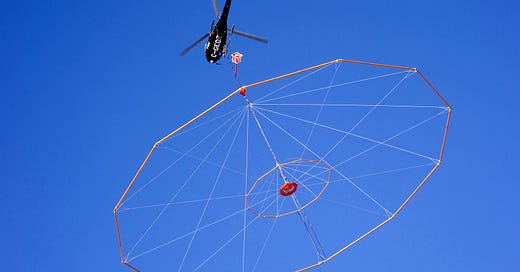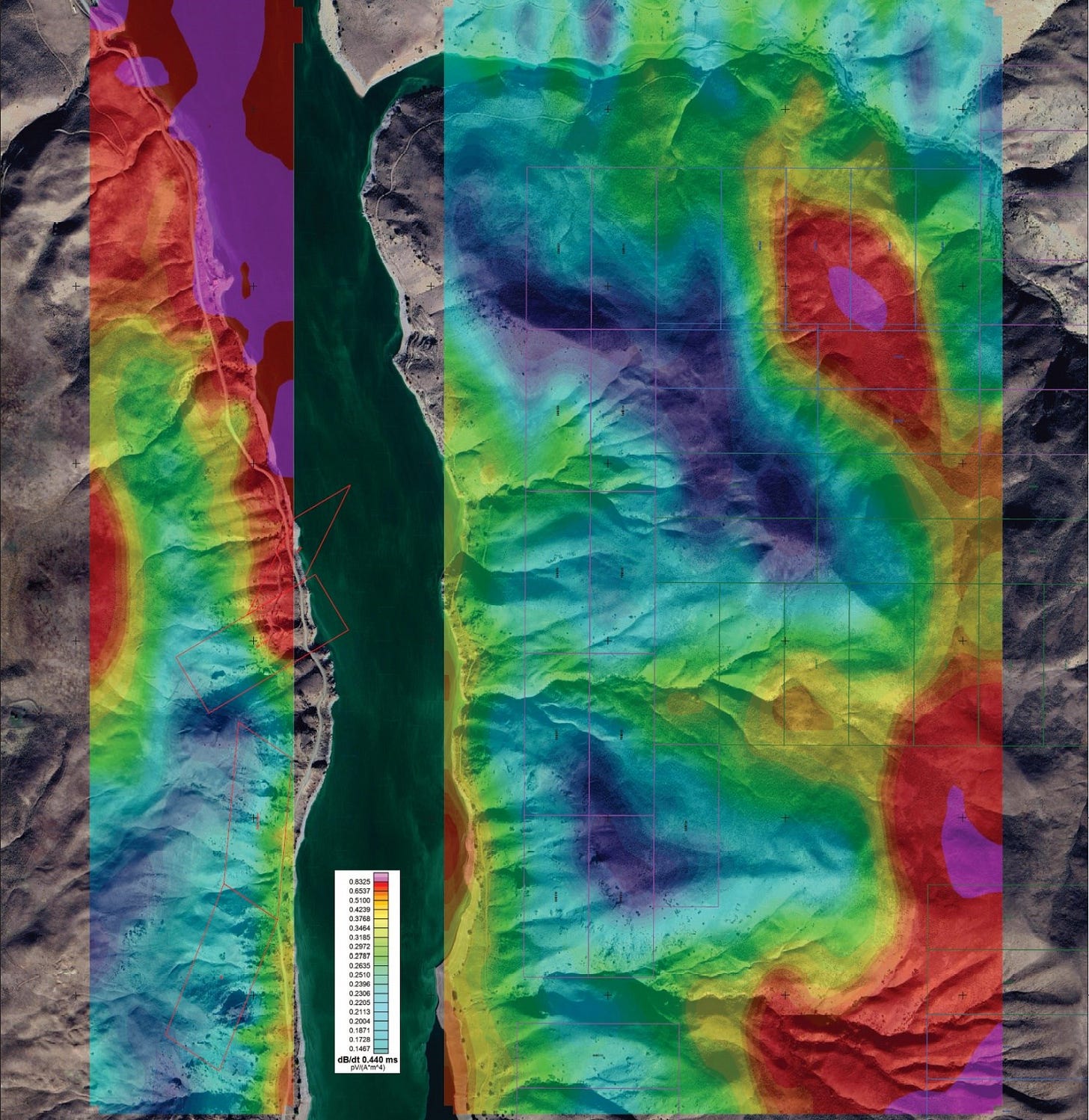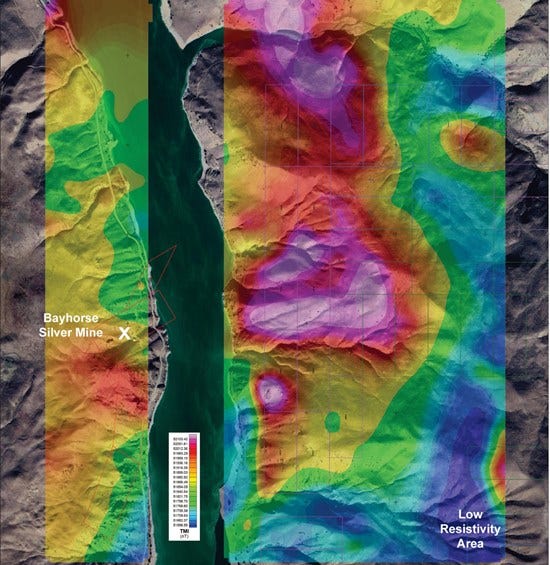Now Do Magnetics: Bayhorse Silver in Idaho
I pray my loyal subscribers will forgive me, but Bayhorse Silver (BHS.V) just put out another press release, this time with the magnetic results from its VTEM survey as well as a more revealing look at the resistivity data.
Last week’s release outlined resistivity results which were very encouraging and suggested that there might be a copper porphyry at the southeast corner of the newly staked Idaho property. But that was just one of the resistivity anomalies. Here’s the map:
On the Idaho side of the Snake River there are, in fact, three resistive lows. Exactly what this means is very much in the hands of the geos and, ultimately, the drill. But, as a general rule, low resistivity suggests mineralized rock and having more is encouraging.
Looking at the Oregon side, the low resistivity extends all the way to the Bayhorse mine workings. Which means it can be drill tested from Bayhorse’s underground drill station sooner rather than later. Drilling underground is less weather dependent than surface drilling and, with luck, the drill might be turning in the next couple of weeks. BHS is aware that its mine produced significant gold previously and the mine is quite close to two other gold mines. The Company's senior geological consultants believe it possible that the silver-rich Bayhorse Mine epithermal mineralization may be underlain by a gold-rich zone. Gold is, after all, an excellent conductor.
This week’s mag results show three mag highs in the middle of and at the north end of the Idaho property. Two, directly across the Snake River from the Bayhorse Mine.
The first thing I noticed about these mag highs was that they are higher than the magnetic signature of the Bayhorse Mine itself, which was included in the VTEM survey and is marked on the map. A lot higher. As with any indirect measure, the elevated mag signatures need a good deal of interpretation, but they represent an excellent set of drill targets. There might well be an Idaho Bayhorse silver mine in due course.
At the Bayhorse mine, the silver is found in the contact zone between hydrothermally altered Andesite, which has a high iron content, that gives the high mag signature, and the contact with the rhyolite. It is a very reasonable assumption that the strong magnetic signatures indicate potentially similar hydrothermally altered andesite and rhyolite contacts.
However, to understand the potential significance of the mag signatures in the larger picture, we need to take a little hike downriver to the Hercules Silver (BIG.V) property on Cuddy Mountain, 44 km northeast from the Bayhorse Mine. Back when BIG announced its discovery hole drilling into what looks like a large copper porphyry I wrote about the similarities between the BHS location and BIG. The key similarity is that they are both at “sutures” between the Izee and Olds Ferry terranes and might be expected to have similar local geologies.
Here’s the Hercules property:
The significant silver at Hercules is contained in what BIG calls the “Hercules Rhyolite”. That rhyolite structure is located about a kilometer to the northwest of what Hercules hopes is a large copper porphyry at greater depth.
Here’s the Bayhorse property on both sides of the Snake with the mag signatures indicated:
The Bayhorse Mine extracts its silver from rhyolite-hosted mineralization. The press release reports that one of Bayhorse’s geologists, “Dr. Clay Conway, P.Geol., has mapped rhyolite-hosted mineralization east of the Snake River in the area underlain by the strong magnetic anomalies. This raises the possibility that another Bayhorse Silver rich deposit may be found at the hydrothermally altered rhyolite contacts.” I think it is safe to name this the “Bayhorse Idaho Rhyolite”. It may well become a mine.
Look where the Bayhorse Rhyolite is relative to the low resistivity zone on the southeast corner of the property. Eyeballing it, I would say the Bayhorse Idaho Rhyolite is just over a kilometer to the northeast of the low resistivity zone. Pretty much exactly where, based on the Hercules results, you would expect it to be.
Now there are all sorts of caveats and fudge factors and disclaimers to be made but the fact remains that the mag survey has basically confirmed that the Bayhorse Idaho Rhyolite is in a similar position relative to the low resistivity zone as the Hercules Rhyolite is to BIG’s copper porphyry. The argument from similarity gets another boost.
But not that similar. The Bayhorse southeast corner target begins 100 meters from surface as compared to the BIG porphyry which mainly occurs below 250 meters. The Bayhorse target goes down a long way, over 425 to 525 meters. And Bayhorse believes that the area outside the current survey, but, no doubt being staked, is likely in the form of a circle or oval. Obviously, this needs to be confirmed by additional VTEM and drilling.
Now back of the envelope calculations are where it gets interesting. Bayhorse believes that the anomaly is circular with a diameter of 0.76 – 1.2 kilometers, let’s call it a kilometer and let’s assume an average mineralized thickness of 450 meters. Pi times R squared times height should give us a rough calculation of volume. If it is all mineralized, that would be, depending on the tons per cubic meter, say 2.4, or around 700 million tons. Of course, this calculation may be fanciful, and we do not know what grade copper Bayhorse will come up with, if there is any, or any amount of gold and/or silver with it. But oh boy! those are large numbers. Plus there are two smaller zones that may have the same stuff. .84%, the Hercules discovery hole copper grade, of 700M tons would be about 5.8M tons of copper. Which is a lot. (I note, these sorts of back-of-the-envelope calculations are very sensitive to the data used and are all about order of magnitude rather than actual values.)
Of course, it is insanely premature to do these sorts of calculations simply because we have just a tiny hint of what, if any, copper endowment BHS has in Idaho. What we do have is another, substantial, piece of the puzzle as the Bayhorse Rhyodite is exactly where you would expect it to be if the Hercules deposit is even a rough guide.
[Note: The market responded favourably to this release with BHS closing at $0.075 after trading as high as $0.08 on a Venture Top Ten Volume of 2.26 million shares - including all Canadian Exchanges the volume was 3.586 million. Preliminary US trading looks to be over 1 million shares.)
[Disclosure: Graeme O’Neill is a friend. I own shares in Bayhorse Silver (BHS.V), a lot of shares, and may buy more or sell some or all at any time. I also have a small position in Hercules Silver (BIG.V)This is not investment advice. Do your own due diligence. ]






